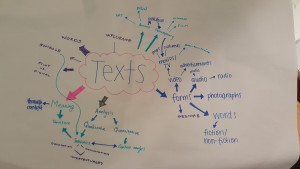Institutions are organising structures of society that deal with social, cultural, political and economic relations, as well as the principles, values and rules that underly these relations. They cannot simply be ideas; they need to have a form (or a currency of some sort). Examples include the police, city council local government, education and journalism.
Marriage as a Social Institution:
- Expectations
- Values (e.g. monogamy)
- Rituals – exchanging vows
- Symbols – rings
- Rights
- Superstitions – unlucky to see the bride in her dress before the wedding
- Legal framework/regulatory
- Meta-institutional frame
- Widely accepted practice
- Cultural ‘rules’
- Social recognition
Media institutions:
- are enduring
- regulate and structure activities
- are ‘collectivist’
- develop working practices
- employees and people associated are expected to share values
- e.g. sports journalist fired for his comments on ANZAC day
- professionalisation and accreditation
- qualifications that are necessary to be regarded in a profession
- public is aware of the status
Institutional Characteristics:
- Facebook
- Way of life
- Ubiquity/Interconnectedness – other apps will ask if you want to “share”
- Raises the question of privacy
- Advertisements from other things you have looked at on the internet show up on Facebook
- Privately-owned
- Differentiation between real life and the life people see on Facebook
- Present a certain portrayal of yourself
- Newscorp
- POWER
- Almost a monopoly
- Channels
- Status
- Fair? Balanced?
- Still needs to adhere to the standards of journalism
- Vertically and horizontally integrated
- Journalistic conventions
- Code of ethics on their website – question the extent to which this is adhered to
- Agenda-setting/framing
- POWER
- Google
- Innovation
- Social conscience
- Do no evil
- Mission: Organise the world’s information and make it useable and useful
- Accessibility – global reach
- Contemporariness
- Google as…
- a culture
- a verb
- brand connected to a way of doing things
- googol – a number with 100 zeros
- Community Media
- Not-for-profit
- Lo-fi filming
- Lack of advertising – commercial aspect much smaller, if it exists at all
- Content
- Local focus
- Passion-driven
- Experimentation – taking risks
- Diversity
- Governance/regulation (or lack thereof)


